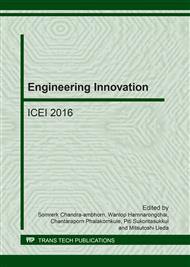p.20
p.26
p.31
p.36
p.42
p.48
p.54
p.60
p.66
Influence of Process Parameters on Electric Upsetting Process by Using Finite Element Modeling
Abstract:
Electric Upsetting Process (EUP) is a process combining the forming process with the electric heating system. It is commonly used to manufacture a preform of a bar with high upsetting ratio, such as an axial shaft. The reliable forming process requires the understanding the effect of process and electrical parameters. Currently, the designer develops this process by trail-and-error. To successfully develop this process, the relationship between the electric heating and the forming parameters needs to be clearly understood. In this study, three parameters are investigated; namely anvil speed, upsetting load and heating voltage. Finite Element Modeling (FEM) is used as a tool for evaluating these parameters. The FEM results indicate that those parameters play significant roles on the material flow as well as the heating characteristics (i.e. temperature distributions and heat flow).
Info:
Periodical:
Pages:
42-47
Citation:
Online since:
January 2017
Authors:
Price:
Сopyright:
© 2017 Trans Tech Publications Ltd. All Rights Reserved
Share:
Citation:


